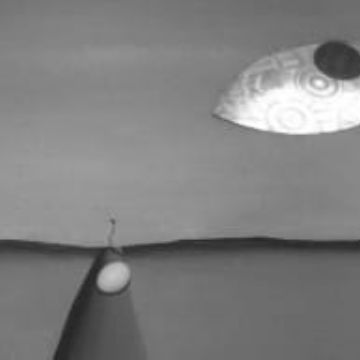Music by Eugeniusz Rudnik

"Józef Robakowski... was the founder of artistic collectives Oko (1960), Zero-61 (1961-1969), and Krąg (1965-1967), and member of the 'Pętla' Student Cine Club (1960-1966). In Łódź, he co-organised the Workshop of Film Form (from 1970), and the 'Stacja Ł' Television Creative Group (1991-1992). He teaches at the National Higher School of Film, Television and Theatre in Łódź. An integral part of Robakowski's work are his statements and self-commentaries, as well as numerous programming texts and manifestoes, e.g. Calling Once Again for 'Pure Film' (1971), Video Art - a Chance to Approach Reality (1976), or Manipulating! (1988). Since the 1960s, Robakowski has remained an active animator of cultural life, as the author of a number of important initiatives (e.g. the Exchange Gallery), organiser and curator of exhibitions, and originator and editor of publications (Nieme Kino, Pst!).
"Robakowski made his first experimental film in 1962, 6,000,000, a compilation of fragments of Holocaust-era documentaries. Photographic activity dominated the early period of his practice, also as part of the collective Zero-61... During that time, besides various photographic experiments (e.g. Photo-Painting, 1958-1967; double-exposure photographs employing mirror-image composition), Robakowski made photo-objects, such as Colander (1960), the photograph of a colander nailed to a plank.... Between 1965-1967, Robakowski was also active on the collective Grupa Krąg, which brought together visual artists, filmmakers, poets, sculptors, and photographers. The artist remembered: 'These exhibitions were like quasi-theatrical happenings, with all kinds of actions, 'tricks', transforming exhibition presentations into spectacles (...) I was closest to a simulated character that didn't really exist, and its name was Józef Korbiela."
"In Łódź... in 1970, the Workshop of Film Form (Warsztat Formy Filmowej) was founded... The Workshop's practice, focuses on an analysis of the new media language (photography, film, video), drew its inspirations from the constructivist tradition and conceptualism, striving to get film rid of 'alien elements' (anecdote, literary forms, narration) and make its language simpler and information denser.
"The artist's analytical position at the time was also manifested in his interest in the peculiarities of human perception towards the still cameras and film cameras, in questions about these tools as extensions of the human organism's mental and physiological functions. During this time, from 1974, Robakowski also embraced a new medium - video.
"The move away from the traditional forms of filmic narration often went hand in hand with a rejection of the representational function. The non-camera film Test II (1971) is among the most radical statements against the narrativity and illusiveness of the traditional filmic message, made by puncturing a dark film tape, as a result of which the viewer was 'attacked' by a strong beam of projector light, producing the effect of afterimage....
"In the 1971 manifesto Calling Once Again for 'Pure Film', the artist wrote, 'Currently the subject of my work is eliminating from film elements characteristic for literature.... through various kinds of experiments, trials, propositions, I will succeed in freeing film from the ballast of habits adopted from literature, uncritically accepted almost universally by both filmmakers and viewers.'
"The first piece made as part of WFF was Robakowski's Market Square (1970), an animated film compiled with still images of the Łódź market square, Czerwony Rynek, made every five seconds on a single day between 7 am and 4 p.m. In the film, that time was compressed to five minutes.
"An important aspect of Robakowski's WFF work were experiments with image and sound - an extra soundtrack, asynchronicity of sound and image, or their mutual relation. The artist experimented with them in Próba II (1971), juxtaposing intense red colour with classic organ music. In Dynamic Rectangle (1971), Robakowski manually shaped a rectangle to music by Eugeniusz Rudnik. The issue of the relation between sound and image returned frequently in the artist's oeuvre, including the films Videosongs (1992) and Videokisses (1992).
"... Since the 1970s, an important role has been played in Robakowski's art by his concept of art as a field of energy transmissions. Hence he has focused in many of his works, which are often biological-mechanical recordings, on issues such as vitality or energy resulting from the contact with a tool. The film are often an effect of an encounter between the mechanical camera and the human body, a confrontation between man and medium. "I want to tell you all that art is energy", Robakowski says, jumping out of water in his Energy Manifesto (2003), as if paraphrasing and referring to a conception by Andrzej Pawłowski, who claimed that "art is an energy field". Robakowski wrote in 1977...

"...n 1975, Robakowski started a series of works called Energetic Angles, which, as he says, reflect my fascination with the problem of the existence of 'Angles' as a kind of intuitive geometry. (...) I've been wondering to what extent geometry, whose goals are intended to be purely practical, can function in art....
"Energy fields have also been realised in Robakowski's art in other ways. In the 1980s, he made films based on recordings of rock concerts, especially his favourite band, the punk group Moskwa. In 1989, in the film My Videomasochisms, he mocked self-mutilating tactics of performance artists: during a for-camera performance, he manipulated various tools next to his face, inflicting a kind of torture on himself. In 1996, in a TV studio, he carried out a happening, broadcast live, during which he was connected to electricity, asking viewers to increase the voltage (I Am Electric)....
- Culture.PL.

















